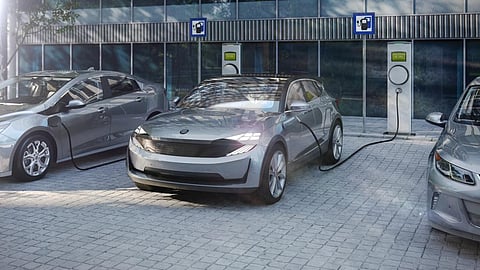US tightens emissions norms for vehicle manufacturers. How the move can inspire India’s EV transition
In a bid to make up for lost ground with vehicle electrification, the United States has proposed very stringent emissions goals. When implemented, the new rules proposed by the US Environment Protection Agency (EPA) estimate that electric vehicles (EV) would account for 67 per cent of light-duty vehicle sales and 46 per cent of medium-duty vehicle sales by model-year 2032.
Though the US was one of the frontrunners in the race to transition to EVs in 2010 (when EVs were introduced in the US), the country lost to Europe and China at the end of the last decade as policies that could have increased production, investment and adoption of electric vehicles were rolled back or phased out.
The ambitions projected with the EPA proposal are clearly designed to make up for lost ground. In fact, they exceed the Biden administration’s 50 per cent EV sales target for 2030 that was announced less than two years ago.
When implemented, light and medium duty vehicles in the country will spew 56 per cent and 44 per cent less CO2 respectively in model year 2032 compared to their 2026 targets.
The model year is a method of describing the version of a vehicle which has been produced over multiple years. The model year may or may not be the same as the calendar year in which the vehicle was manufactured.
To achieve these numbers, carbon emissions from light-duty vehicles will have to be limited to approximately 49 grams per kilometre by 2032. To put that in perspective, US emission standards for light duty vehicles is 102 gm CO2 / km at present.
In comparison, the current Corporate Average Fuel Consumption (CAFC) standards in place in India is 113 gm / km, according to Stage II (post-2022) of the standards. The CAFC standards were first implemented in India in 2017-18 and the Stage 1 standard was 129.8 gmCO2 / km till 2022.
However, an assessment of Stage 1 standards shows that all car companies have not only met the 2017–18 standards but have also exceeded them by a margin. The average fuel consumption of new light duty vehicles sold in 2018 had overshot the target by 9 per cent that year, according to an independent evaluation by the International Energy Agency (IEA).
India has not only set weak targets that the industry can meet easily, but it has further weakened the targets by giving away super credits or extra points for ineffectual technological approaches like six speed transmission that normally all big and luxury cars use or tyre pressure monitoring that depends on driver’s behaviour.
Clearly India is missing out on the opportunity to deploy fuel efficiency regulation as an effective tool to expand electrification in India, much as the US is trying to engineer now.
The proposed EPA rules do not explicitly direct automakers to sell a particular number of vehicles (the zero-emissions vehicles mandate) to achieve fleet-wide fuel efficiency targets. It moves away from the California mode of banning sale of gas-powered vehicles and focuses on very stringent criteria for CO2 emissions instead.
When the rules get enacted, automakers will have to invest more in EVs to comply as well as develop cleaner technology for petrol / diesel-powered cars. The proposal points at a host of emission control technologies and standards that can allow manufacturers to meet the performance-based standards that works best for their vehicle fleets.
India has the opportunity to set up fuel efficiency standards for all segments of vehicles. At the moment, standards have been implemented only for passenger cars so far and not for other vehicle segments, including heavy duty vehicles, two-wheelers and other commercial vehicles. But the standards for the passenger cars are too lenient to make a difference and represent a lost opportunity for electrification.
Apart from building fuel economy regulation to push EV production, India could also review the localisation rule (use of local components in vehicles) for eligibility to avail subsidies. The incentive programme has been put on hold and the government is investigating several automakers for inability to provide proof of local content in their vehicles.
The government’s demand creation-oriented Faster Adoption and Manufacturing of (Hybrid &) Electric Vehicles in India (FAME) scheme offers companies a discount of up to 40 per cent on the cost of locally manufactured vehicles.
While the localisation rule is valid on its own, it fails to recognise the manufacturing vacuum in the EV ecosystem in India. In addition to the government’s supply-foriented production-linked incentive scheme 'National Programme on Advanced Chemistry Cell Battery Storage’ that is directed at large manufacturers, it is necessary to design policies for the MSME supply base and, more significantly, players engaged with machinery and equipment.
The policy framework will have to also empower and aid the development of manufacturers of equipment such as vacuum slurry mixers, electrode coating and drying lines, calendering machines, vacuum sealers, spot welding machines, electrolyte filling machines, battery formation systems and aging cabinets.
Starting April 18, the US is also deploying a localisation rule like India, though the comparison ends there. The EV component manufacturing ecosystem is an already developed market in the US. In addition, the new eligibility rules to avail the $7,500 subsidy for purchase of new EVs require that certain percentages of battery parts and minerals come from North America or countries with which the US has free trade agreements.
The new clause is expected to reduce the subsidy in half for some vehicles and may work as a deterrent to fresh sales of EVs. At the same time, access to componentry from other countries can support the building of a robust ecosystem that will strengthen market forces and help it grow, a model that India may want to look at customising for its own requirements.


